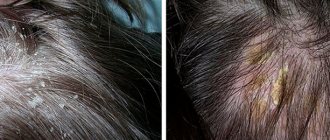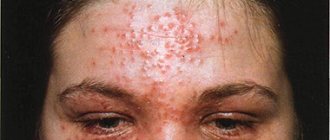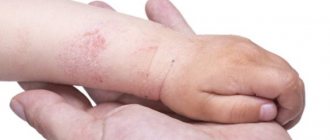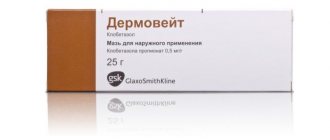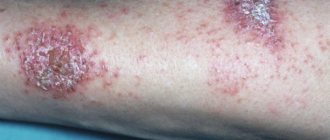Causes of eczema
Among the main causes of this disease, doctors call a violation of the barrier function, when the outer layer of the epidermis fails to protect the skin from the aggressive effects of various external factors. On the other hand, through a broken barrier, the body loses a large amount of water, which leads to dehydration and even greater skin vulnerability.
In a large number of cases, the tendency to eczema is hereditary. Depending on the type of eczema, provoking factors may include:
- Aggressive skin care: washing with soap, using harsh cosmetics with sulfates, excessively long water procedures and hot water. All this leads to the washing away of the protective sebaceous film from the surface of the epidermis; accordingly, the surface of the body loses water and protection from external influences.
- Dry air, stay in a hot climate, bath.
- Allergens of various origins: food, pollen, mold, dander and animal hair.
- Contact allergens: nickel, latex,
- Stress.
Types of eczema
Eczema is manifested by skin rashes and a number of other general symptoms, but according to the origin and characteristics of the course, several types of this disease can be distinguished:
- Atopic dermatitis affects adults and children, and is associated with dehydration of the skin, which cannot withstand the harmful effects of the environment and allergens entering the body. In young children, symptoms occur on the cheeks, in older children - in the bends of the elbows and knees, on the neck, but in general the location can be anywhere.
- Contact dermatitis is a reaction to local exposure to an allergen or irritant. It occurs precisely at the point of contact. Contact allergens include some metals (nickel, cobalt), latex, the juice of certain plants, as well as many components of household chemicals and cosmetics.
- Seborrheic dermatitis is also associated with dysregulation of the sebaceous glands, and affects the scalp, less often the forehead, the area behind the ears, the wings of the nose and the upper back. Appears as fatty, dense crusts or scales, and in infants the condition is known as gneiss.
What kind of disease is this?
An inflammatory disease of the upper layers of the skin, in which constantly recurring rashes of various types occur. If medical care is not provided, eczema can lead to serious consequences, for example, the development of purulent inflammation on the skin (see Eczema on the fingers). Therefore, at the first signs you should immediately consult a doctor.
Causes
Unfortunately, doctors cannot yet determine the exact cause of the development of eczema. But there are certain factors that contribute to the manifestation of pathology:
- mechanical damage to the skin resulting from injury;
- genetic predisposition;
- fungal skin infection;
- the body's reaction to various allergens;
- weak immune system;
- hormonal imbalance. As a rule, hormonal imbalance is observed in adolescents during puberty, as well as in pregnant women;
- negative impact of detergents and cosmetics containing chemically aggressive components;
- sudden changes in temperature;
- bites of various insects;
- violation of metabolic functions in the body;
- disruptions in the functioning of the endocrine system;
- disruption of the gastrointestinal tract (GIT);
- neuroses, stress, and increased anxiety are common.
Types of eczema
There are several types of dermatological diseases, which differ in the causes of development and characteristics of the course. The table below shows the most common of them.
Table. Main types of eczema.
| Type of disease | Description |
| Eczema of lips | Accompanied by damage to the lips, or rather, the border. A non-wetting form of eczema appears in the form of cracks, crusts or scales on the surface of the lips. |
| Seborrheic | It mainly affects those areas of the body where the most sebaceous glands are located (on the shoulder blades, armpits or head). Seborrheic eczema is accompanied by the appearance of pink-yellow spots on the skin. |
| Varicose | It occurs against the background of metabolic disorders, and is also a concomitant sign of varicose veins. |
| Microbial | Often, the microbial type of eczema forms at the site of an ulcer, wound or fistula, affecting large areas of the patient’s body. Accompanied by the appearance of grayish-yellow crusts on the skin. Pathology occurs against the background of nervous disorders or immunodeficiency. |
| True | It affects the skin of the face, and then gradually spreads to the upper and lower extremities. True eczema is accompanied by the appearance of water blisters on the skin, itching and chills. |
Characteristic symptoms
Regardless of the type of eczema, the main symptoms that all patients have to face include burning, constant itching and skin rashes of various types. As the pathology develops, the affected areas begin to peel off, and wounds remain in the place of previously formed vesicles. Lack of medical attention or contracting a bacterial infection can lead to the formation of pustules.
Is eczema contagious?
Eczema has skin symptoms such as rashes and peeling that are noticeable to others, which is why people often wonder if the condition is transferable to others.
This question of whether eczema is contagious is very important, since the appearance of the skin is unpleasant to contemplate and often repels others, which leads to stigmatization, social isolation and various psychological problems, from neurosis to depression. In many countries, the psychological aspects of this disease are studied very deeply because it greatly affects the quality of life. Both the patient himself and loved ones must have a good understanding of the nature of the disease, be confident in their own safety, and that eczema can be cured.
Is eczema inherited from person to person?
Research in recent years has shed light on the cause and mechanisms of development of the disease. Thus, its hereditary nature has been deeply studied. Observations of identical twins have shown that if one of them has this problem, there is a greater than 80 percent chance that the other will develop it too. This confirms that eczema is inherited. A number of genes have been discovered that are found in patients, but often various combinations of genes are to blame for the disease, as well as the interaction of genetic predisposition with environmental conditions and other external factors. There is no single mutation that is present in all patients and leads to pathology.
The CARD11 gene encodes a protein that plays a key role in the signal transmission mechanism in the receptors of T-lymphocytes, immune cells, and when mutated, these cells can no longer work correctly. Mutation of this gene occurs in patients with atopic dermatitis. To understand the mechanisms through which changes in the CARD11 protein lead to skin damage, the scientists conducted several experiments on cell cultures and also observed patients with a family history of dermatitis. In each of the four families, mutations were detected in different parts of the CARD11 gene, but the disturbances in the functioning of the receptors were very similar to each other. The number of T-lymphocytes remains the same, but these cells function incorrectly and react incorrectly when foreign bacteria and fungi enter the body. This leads to decreased immunity and frequent infections. This probably reduces the barrier function of the skin, which is why it is damaged. In this separate, hereditary form of atopic dermatitis, a tendency to bacterial and fungal diseases is combined with a rash and dryness of the body. The autosomal dominant pattern of inheritance characteristic of this gene means that the disease appears in every generation, regardless of gender, and one copy of the mutant DNA is enough to cause symptoms of eczema.
A mutation in the FLG gene occurs in 30% of patients with atopy. This gene contains the profilaggrin protein, which is necessary for the formation of the correct structure of the outermost layer of the epithelium. Proteins formed from profilaggrin help create a strong barrier that keeps water inside and prevents foreign substances such as toxins, bacteria and allergens from penetrating the skin. These proteins are also natural moisturizing factors that help maintain the elasticity of the outer layer of the skin. Changes in the FLG gene can cause damage and rashes. Not all carriers of this mutation develop atopic dermatitis, however, when exposed to any external triggering factors, the risk increases significantly. Research shows that this exposure triggers epigenetic changes in DNA. In this case, the DNA sequence itself remains the same, but the regulatory mechanisms associated with this gene change. The activity of the gene changes, this affects the synthesis of the proteins encoded in it. In predisposed people, this provokes allergic reactions. The FLG mutation is also inherited in an autosomal dominant manner, but due to epigenetic influences, not all carriers become affected.
Classification
Depending on the characteristics of the course, doctors distinguish between chronic and acute forms of dry eczema. The development of the former is influenced by various mechanical and chemical factors, and exacerbations of symptoms are associated with seasonal changes. The chronic form is considered more prone to relapse than the acute form, and it is not so easy to treat. Under certain conditions, the disease can transform into weeping eczema, which has a more acute course.
Forms of dry eczema
The development of acute eczema is directly related to the patient’s body’s reaction to various factors, but with their successful elimination, the signs of pathology quickly disappear. Causal factors also include severe stress, physical and mental overload. Unlike the chronic form, with acute dry eczema, relapses occur very rarely, so the prognosis is most often favorable.
Localization of dry eczema
Exposed areas of the body, where the skin loses moisture very quickly, are more prone to the appearance of symptoms of the disease. Based on localization, doctors divide several types of pathology.
- On the face. Such eczema is diagnosed extremely rarely, since there are many sebaceous glands on the facial area that do not allow the skin to quickly lose moisture. Symptoms of eczema appear on the face, as a rule, when these glands are malfunctioning;
- On foot. Eczema can often be seen on the outside of the lower legs, where very few sebaceous glands are present. The skin on the legs is poorly protected from negative external factors;
- On hands. One of the most “popular” parts of the body affected by dermatological disease are the hands. Moreover, symptoms of dry eczema on the hands appear on the hands, palms or fingers. In these areas, the skin is very vulnerable to negative factors, which is associated with a small number of sebaceous glands.
Stages of development of dry eczema
Does eczema spread through contact with a sick person?
Through direct contact, diseases that belong to the group of infectious diseases are transmitted. These diseases are caused by bacteria, viruses or fungi. The transfer of these microorganisms to another person upon contact, through household objects, with drops of saliva during coughing, leads to the spread of pathology. This property is called contagiousness. The vast majority of types of eczema are not infectious, which means they are not contagious. Pathology cannot pass from sick to healthy, so it doesn’t matter whether you touch the affected skin or use a shared towel, eczema cannot appear from this.
In rare cases, when the affected skin becomes infected with bacteria, it can spread through contact with another person, and if they also have eczema, there is a possibility of infection. So, if you already have this skin condition, you may get the organism from someone else and your eczema will become more complicated by infection. However, this is a very unlikely scenario, and bacterial inflammation is more likely to occur if personal hygiene is not followed.
Eczema and sex
Infections caused by viruses, bacteria or protozoa are transmitted sexually. Eczema is not an infection; this skin disease does not belong to the group of sexually transmitted diseases. Therefore, it is impossible to catch this condition from your partner during sex.
If you have symptoms similar to eczema after sexual intercourse, and your partner has the same symptoms, you should immediately consult a doctor. This means that the rash is not caused by eczema, but by an infection, and if you do not get a diagnosis and treatment in time, there is a high risk of complications associated with both sexual function and infertility, and with the general well-being of the body. Thus, the herpes simplex virus causes a rash that can be confused with eczema. However, this disease must be treated with antiviral drugs. Without treatment, it brings a lot of unpleasant sensations, and if the body weakens, it can lead to a severe form of encephalitis. Herpes is also dangerous during pregnancy, for the fetus (unlike eczema).
Eczema and blood transfusion
When asked whether eczema can be contracted through a blood transfusion, doctors have a clear answer. No, this disease is not transmitted from person to person through blood. It is known that a number of genes may be responsible for the symptoms of eczema. When a blood transfusion occurs, blood cells that carry the genetic material of another person enter the body. Therefore, doubts may arise: whether the eczema gene will be passed on in this way. The fact is that blood cells are mature and formed. They do not participate in further division and are not sources for subsequent generations of red and white blood cells. They serve for a certain time, performing their functions, and then are disposed of in the spleen. New cells are supplied by the bone marrow. When a person requires a transfusion, his own bone marrow does not have time to grow the required number of cells (for example, during bleeding). Then he is helped by injecting the blood of another person. Even if these new cells have a hereditary defect, they will work out before causing symptoms of atopic dermatitis, and they will be replaced by healthy own cells that the bone marrow has grown in a calm environment.
How to prevent the disease
In order not to encounter unpleasant symptoms of eczema in the future or to weaken the course of an existing disease, you must follow certain recommendations:
Features of eczema prevention
- Maintain hygiene of your body and facial skin. Wash your face every day and take a warm shower, use special products (choose a product specifically for your skin type), wipe dry with a clean towel;
- promptly treat all dermatological diseases that may cause eczema. The same can be said for varicose veins;
- pay special attention to swelling or scabies - these are warning signs;
- Before each meal, as well as after visiting hospitals, shops and other public places, be sure to wash your hands with soap;
- if even minor ulcers or scratches appear, use iodine to treat the affected skin;
- Women are not recommended to wear nylon tights or stockings frequently. This material does not allow air to pass through, so the skin cannot breathe and function normally;
- Change your wash brush and washcloth regularly, as various bacteria can accumulate on them. It is recommended to replace it at least once a month.
Prevention of eczema
To prevent eczema during pregnancy, experts recommend following a special drinking regime. This is due to the fact that allergens can enter the placenta along with blood, which poses a threat to the health of the unborn child. You also need to monitor your diet and take vitamin complexes containing vitamins A and B. The combination of all these measures will prevent the occurrence of eczema and other skin pathologies.
Video - Routes of transmission and symptoms of eczema
source
Treatment of eczema
In treatment, a number of drugs are used that affect the mechanism of the disease and eliminate symptoms.
- Glucocorticoids. These hormonal drugs are prescribed locally in the form of ointments or creams. They regulate the functioning of immune cells, thus eliminating all symptoms of inflammation. They are effective against rashes, itching, and redness. Depending on the severity of the process, prevalence and localization, hormones of varying strengths are prescribed.
- Calcineurin inhibitors act similarly to hormonal agents, blocking the process of inflammation, but are free from the side effects of glucocorticoids and are better tolerated.
- Antihistamine tablets are effective against itching.
- Combined nonspecific drugs are good for treating mild forms or in combination with specific therapy. This is a wide range of products that contain emollients, oils, antiseptics, substances that affect inflammation and regeneration.
Gene therapy is not used in the treatment of eczema, since there is no one specific gene that needs to be changed to get rid of this disease. At this stage of medical development, it is impossible to come up with a genetic technology that would help in the fight against dermatitis.
Diagnostic features
Without the addition of a secondary infection or other pathologies, dry eczema is diagnosed quite easily. After a visual examination of the patient, the doctor takes a medical history to identify the possible cause of the disease. If dry eczema is suspected, a laboratory blood test is mandatory.
Diagnosis of dry eczema
The symptoms of asteatotic eczema are similar to those of stasis dermatitis, so if it is difficult to make a diagnosis, the doctor will prescribe a biopsy of the affected tissue. This is done to differentiate the pathology, as well as to determine a possible bacterial or infectious lesion. Once the diagnosis is made, the patient is prescribed an appropriate course of therapy.
Differential diagnosis of dry eczema

